When traveling abroad, get a policy from one of the best travel insurance companies. You can get a 5% discount on Heymondo, the only insurance that pays all medical bills upfront for you, HERE!
Valley of Fire State Park has one of the most incredible natural landscapes and is just a short drive from the Vegas Strip. This geological wonderland boasts stunning works of nature you must see to believe, so it’s well worth the short drive!
The Valley of Fire is a National Natural Landmark and the first state park, so it’s one of the best things to do in Nevada. It may have been founded in 1934, but the sandstone structures you’ll find here date back millions of years. And yes, the Valley of Fire lives up to its name, as the red sandstone glows brightly in the afternoon sun.
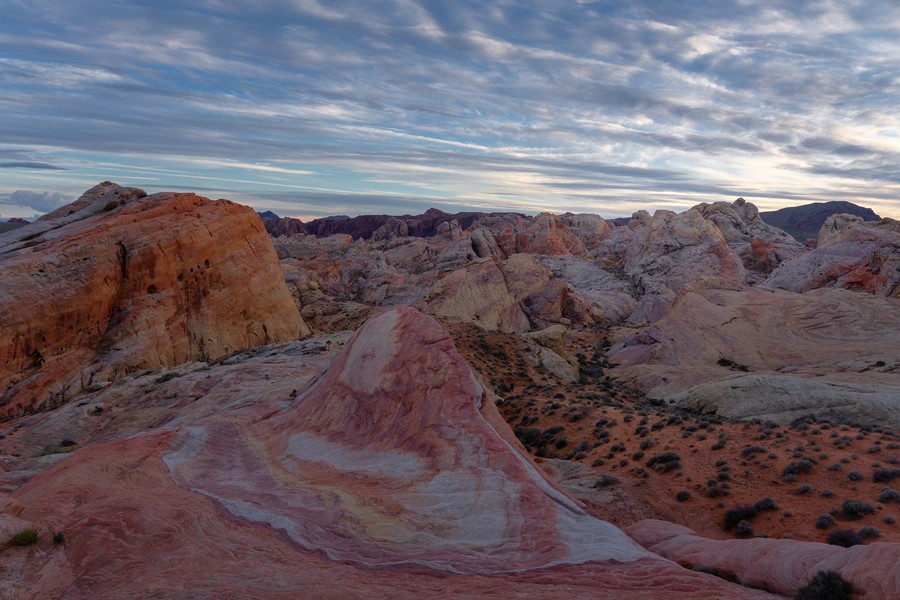
Rainbow Vista, one of the best hikes in Valley of Fire
Along with the Aztec sandstone, you can see rock formations made of limestone, shale, and silica, as well as petrified trees, canyon peaks, and desert flora and fauna. We missed this state park during our first trip to Sin City, but now that we’ve seen it, we’re convinced it’s one of the best day trips from Las Vegas.
In this guide, I’ll share the best things to do in the Valley of Fire, as well as camping info and tips for your visit. From narrow slot canyons and pastel-colored rocks to natural arches and sweeping desert views, I know you’ll love this place as much as we did.
Best things to do in Valley of Fire State Park
There is something for everyone at Valley of Fire State Park, including hikes for all skill levels, the Scenic Loop Drive, wildlife viewing, and impressive geological wonders.
Keep reading to learn more about the 15 best things to do in the Valley of Fire!
1. Fire Wave, one of the best Valley of Fire hikes
First, the Fire Wave at Valley of Fire is a must-see. This massive sandstone formation is famous for its interchanging streaks, and the hike to get there is great, too. It’s one thing to see images of the striated slickrock, but when you’re standing in front of it, the sight is breathtaking.
While walking to the Fire Wave, you’ll pass colorful cliffs and vivid sandstone mounds. This is just a taste of what’s in store before you see the expansive landscape of red, pink, and orange stripes.

1. Fire Wave, one of the best Valley of Fire hikes
As you descend this carved-out area, you’ll be amazed at how painterly the natural stone looks. Be sure to check out the western end of the depression bowl, where you’ll see the most impressive fiery striations and waves.
To get there, you’ll take the Fire Wave Trail, which is one of the most popular Valley of Fire trails.
2. Mouse’s Tank, the Valley of Fire’s scenic drive
Mouse’s Tank in the Valley of Fire is another stop you should add to your list. This natural basin got its name from a Paiute Indian nicknamed Mouse, who hid out in this area and used the basin as a water hole after being deemed an outlaw in the 1890s.
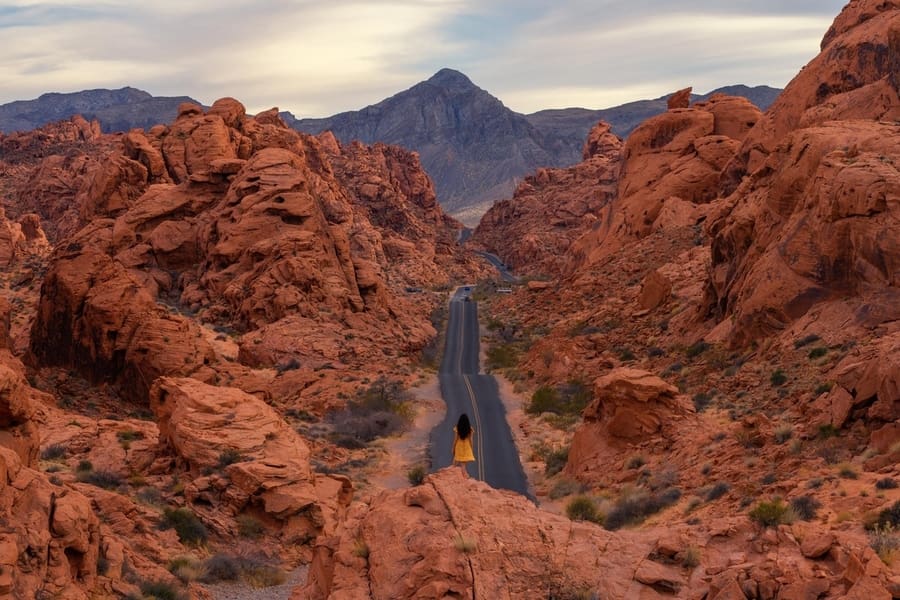
2. Mouse’s Tank, the Valley of Fire’s scenic drive
There is also the Mouse’s Tank Trail, which is an excellent Valley of Fire hiking trail. What makes this half-mile loop so great are the petroglyphs you’ll see along the way. As you make your way to the basin, you’ll pass several stunning rock walls with prehistoric art. These ancient symbols reflect the ancient Native Americans’ way of life and depict people and animals.
The trail may be short, but I encourage you to spend time admiring the petroglyphs. Of course, be mindful and treat these rock etchings with care, as they’re thousands of years old.
3. Rainbow Vista, a top attraction at Valley of Fire
The Valley of Fire’s Rainbow Vista is a landscape of canyons, domes, ridges, towers, and valleys. These geological structures were carved millions of years ago, and, to this day, they’re something you must see when visiting the park.
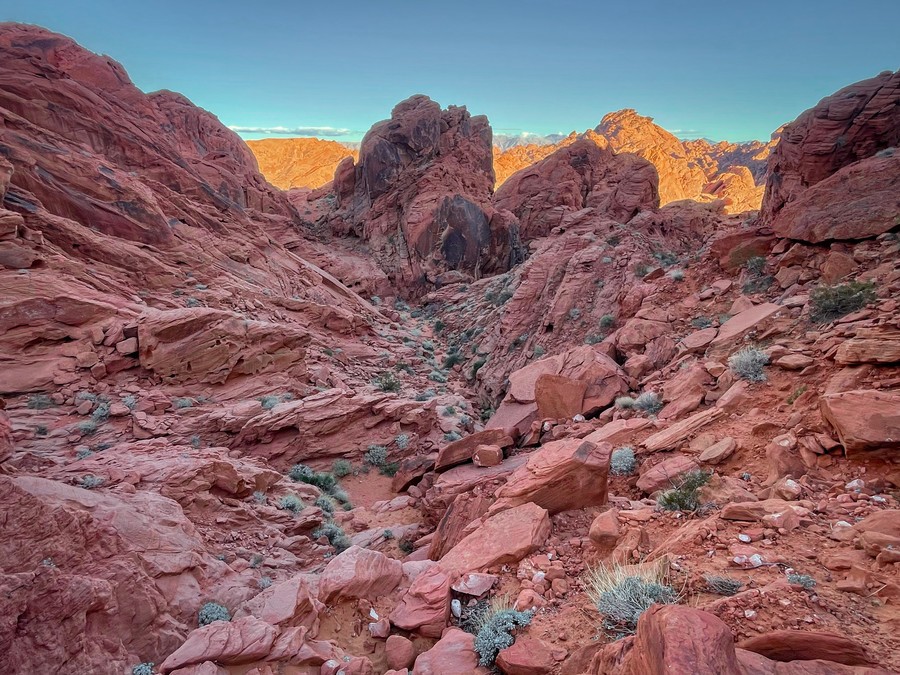
3. Rainbow Vista, a top attraction at Valley of Fire
Moreover, the trail to Rainbow Vista is one of the best hikes in the Valley of Fire. The scenic path is just over a mile long and leads to an incredible lookout point where you can take in the immensity of the canyons. There’s no doubt that it’s a unique area, and the colorful spectrum is a nice break from the red sandstone that defines the park. As you traverse the trail, you’ll notice different hues of red, orange, yellow, pink, and gray, as well as green desert shrubs, creating the perfect photo op.
4. Pink Canyon
The Pink Canyon at Valley of Fire is unmarked, but that doesn’t mean you should pass it by. This pastel-colored slot canyon is close to the Fire Wave, so you won’t have to go out of your way to see it.
Also known as the Pastel Canyon, this area is defined by its lovely pink hues, as well as pastel shades of orange, yellow, and white.

4. Pink Canyon
You can get to the Pink Canyon via Mouse’s Tank Road; the trailhead is between Fire Canyon Road and the Fire Wave parking lot. Walking the narrow path among the smooth canyon walls, you’ll feel as if you’re traveling to another world. The carved sandstone creates intriguing shapes that look like abstract sculptures or maybe melted ice cream!
Remember that the Valley of Fire Pastel Canyon trail is unmarked, so to avoid getting lost, simply go back the way you came.
5. See Arch Rock, something to do in the Valley of Fire with kids
Arch Rock at Valley of Fire is a nice pitstop you can make while traversing the 2-mile Scenic Loop Road.
Millions of years of torrential rain and strong winds created this natural arch, which will eventually collapse due to natural forces. That said, you can still see this delicate arch, and while you can’t climb it, you can walk around it.

5. See Arch Rock, something to do in the Valley of Fire with kids
Visiting this beautiful sandstone formation is one of the best things to do in the Valley of Fire, especially with kids who can’t walk very far. Arch Rock is best seen from the Valley of Fire Scenic Drive Loop. Also, along this road is Piano Rock, another interesting structure that indeed resembles a grand piano.
6. Atlatl Rock, the best display of petroglyphs in Valley of Fire
If you want to see petroglyphs in the Valley of Fire, another area to check out is Atlatl Rock. This big boulder is easy to spot since it’s on the west side of the Scenic Drive Loop. That said, I recommend stopping here so you can get an up-close view of the ancient Native American rock art.
These 4,000-year-old petroglyphs depict animals and people. If you look closely, you’ll see that the figures are throwing spears wound with atlatls or thin cords that give the spears more force and rotation.
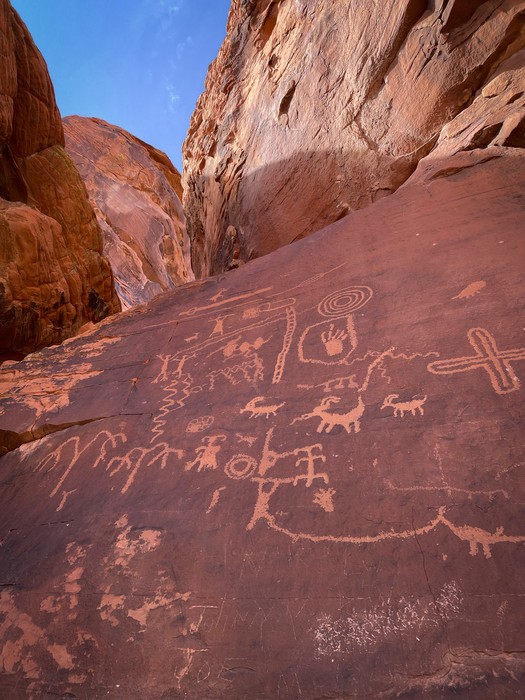
6. Atlatl Rock, the best display of petroglyphs in Valley of Fire
As I said, Atlatl Rock is right off the Scenic Loop, so you won’t have to walk far to get to it. A metal staircase leads right up to the petroglyphs on the side of the boulder; it’s about 50 feet up and very stable.
This area also has some picnic tables, an interpretive trail, and the Atlatl Rock Campground, so it’s perfect if you want to spend some time exploring.
7. Elephant Rock, something you must see at Valley of Fire State Park
One of the most unique geological structures in the Valley of Fire is Elephant Rock. As the name suggests, this massive rock formation looks like an elephant with a rigid stone trunk. It’s certainly worth seeing and, if you’re using the park’s east entrance, it will be the first thing you see.
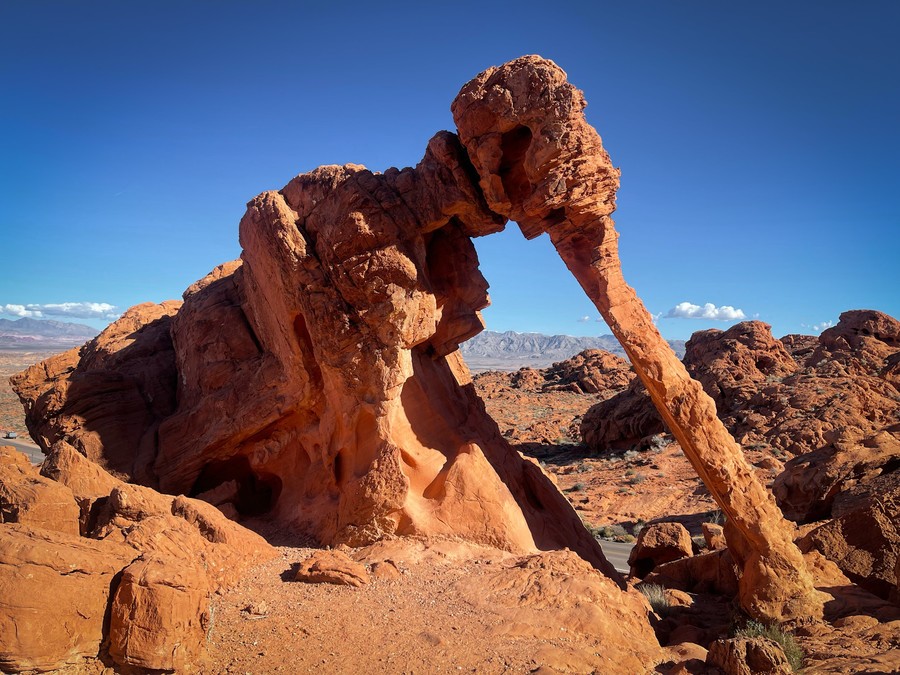
7. Elephant Rock, something you must see at Valley of Fire State Park
The east entrance is also where you’ll find the Elephant Rock Trail, a simple loop you can do with kids. It’s incredible how much this natural arch resembles an elephant, and I recommend walking around the structure to appreciate it from all angles. Depending on the time of day, the sun may hit the rock perfectly, so it takes on a fiery glint.
This arch stands out from others in the park because it’s not made of one rock. Rather, the elephant consists of several brick-like rocks and columns that nature expertly pushed together. Without a doubt, visiting Elephant Rock is one of the best things to do in the Valley of Fire. Just be careful not to climb on the formation, as it’s quite fragile.
8. The Beehives, an impressive structure in Valley of Fire, Nevada
Right across from Atlatl Rock, you’ll find another popular sight at Valley of Fire State Park, the Beehives. Yes, these geological formations really do look like beehives, so be sure to bring your camera!
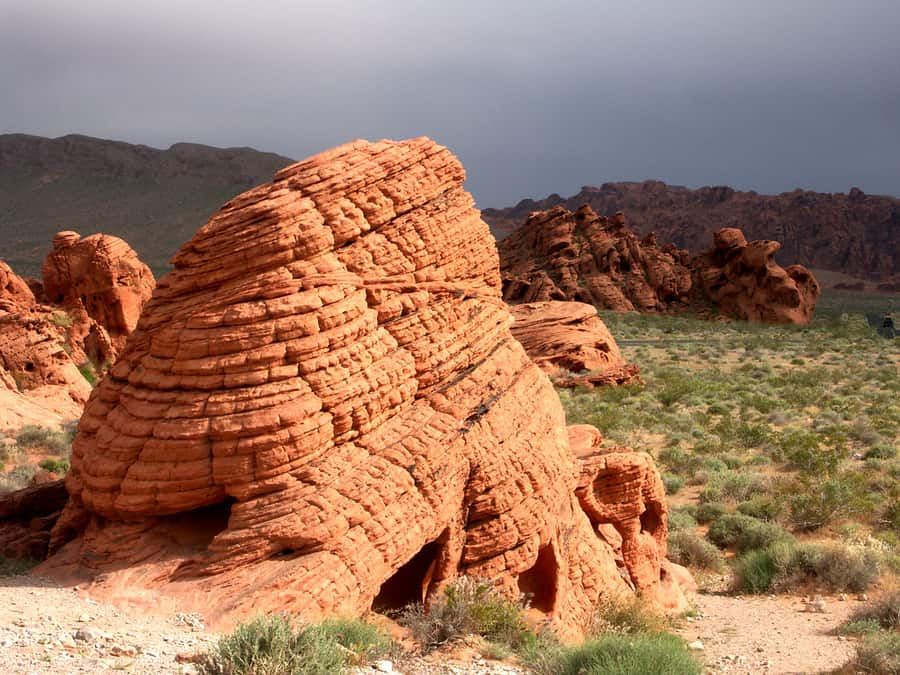
8. The Beehives, an impressive structure in Valley of Fire, Nevada
Besides being an impressive attraction, the beehives are a great place to learn more about the geology of the park. These sandstone beehives are an excellent example of cross-bedding, in which several rock layers go in different directions. The beehives’ layers of silt were displaced by wind and rain, and you can tell which way the wind was blowing based on the angle of the layers.
A short path leads to the beehives, so you won’t have any trouble finding this unique formation.
9. White Domes, the most popular slot canyon in Valley of Fire
The White Domes area is one of the most beautiful things to see in the Valley of Fire, so I recommend checking it out. To get there, take the White Domes Trail, a one-mile hike through a stunning slot canyon.

9. White Domes, the most popular slot canyon in Valley of Fire
As you walk through the narrow canyon, you’ll notice the striped walls alternating between orange, yellow, and white. The further you go, the more varied the landscape becomes, alternating between slot canyon, desert, large sandstone formations, and sweeping vistas.
The trail takes you past striated rocks, natural arches, and amphitheaters, making it one of the most popular hikes in the Valley of Fire. You’ll even see the remnants of an old movie set from the 1960s, which used this area to build a hacienda and sandstone ruins.
10. Visit the Fire Cave, another fun thing to do in the Valley of Fire
The Seven Wonders Loop is an amazing hiking trail in the Valley of Fire, and the first wonder you’ll see is the Fire Cave.
Like many other geological structures in the park, the Fire Cave is a wonderful work of nature. Shaped by years of erosion, it’s one of the most beautiful formations in the Valley of Fire. It may be small, but don’t let that fool you!
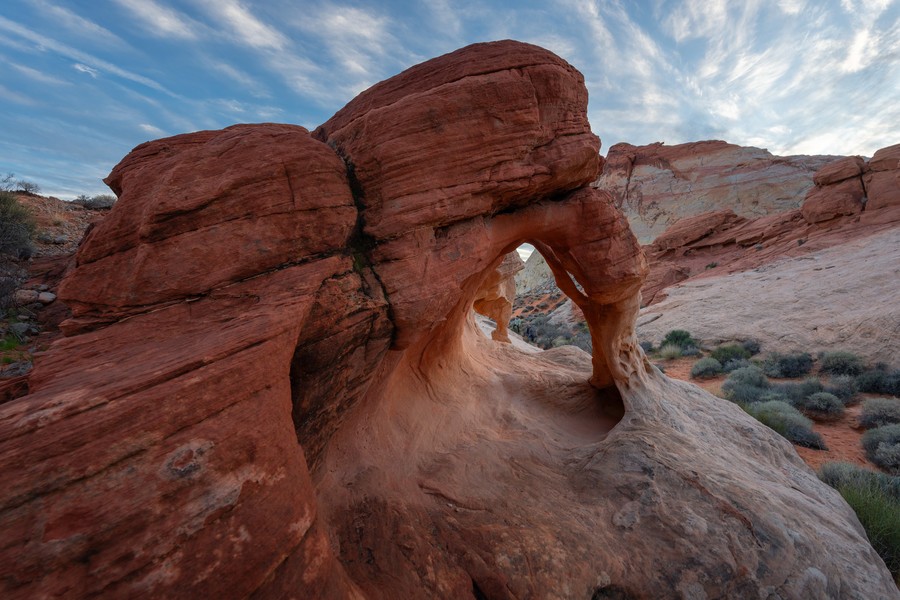
10. Visit the Fire Cave, another fun thing to do in the Valley of Fire
One of the coolest aspects of this cave was the Windstone Arch, a thin natural arch that sloped overhead. Unfortunately, the arch has since collapsed, but you can see the cave, so I think it’s still worth visiting.
When the desert sun hits just right, the Fire Cave’s pink rocks seem to glow. You can carefully step inside the cave to escape the sun, and while it’s tiny, the interior walls boast some incredible patterns. The organic textures and divots contrast the red, orange, and pink-striped walls, creating one of the most fascinating scenes in the park.
11. Balanced Rock, a cool thing to see at Valley of Fire State Park
After stopping by the Valley of Fire Visitor Center, you’ll be just a few steps away from Balanced Rock. The short hike to this scenic viewpoint will lead you to a precarious rock formation.
As you can imagine, this geological structure balances on one side, so it looks like the sandstone could collapse with a strong gust of wind. Fortunately, that hasn’t happened, so you can still visit this interesting natural attraction.
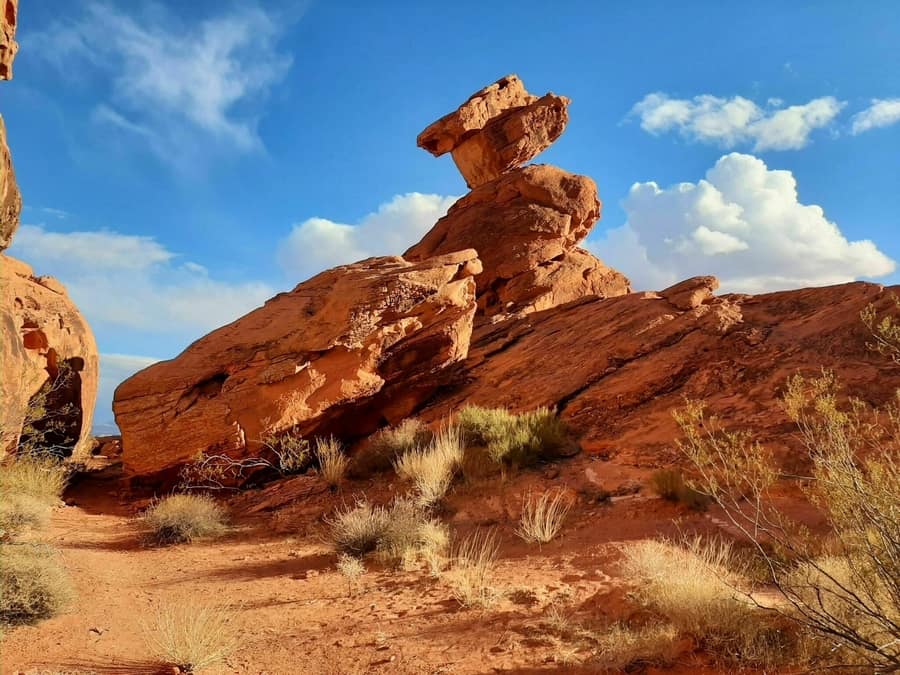
11. Balanced Rock, a cool thing to see at Valley of Fire State Park
Balanced Rock stands about 20 feet high, and if you look closely, you can see that the top rock resembles a head with a nose-shaped protrusion. Below the head, the rock column narrows, creating the fragile balancing act that makes this structure so famous.
Visiting Balanced Rock is an awesome thing to do in the Valley of Fire, especially since it’s close to the Visitor Center. While you can get close to it and admire the weathered rock layers, be careful not to climb on it.
12. Petrified Logs
A common sight at Valley of Fire, Nevada is petrified wood or petrified logs. These are logs that have been exposed to the elements for years, causing them to become fossilized.
Over millions of years, strong wind gusts and flooding brought pine tree stumps and logs into the park. Today, you can see petrified wood throughout the desert. The color of the wood depends on the minerals it contains, such as carbon, copper, iron, or manganese. The Valley of Fire has two main areas where the petrified logs are concentrated.
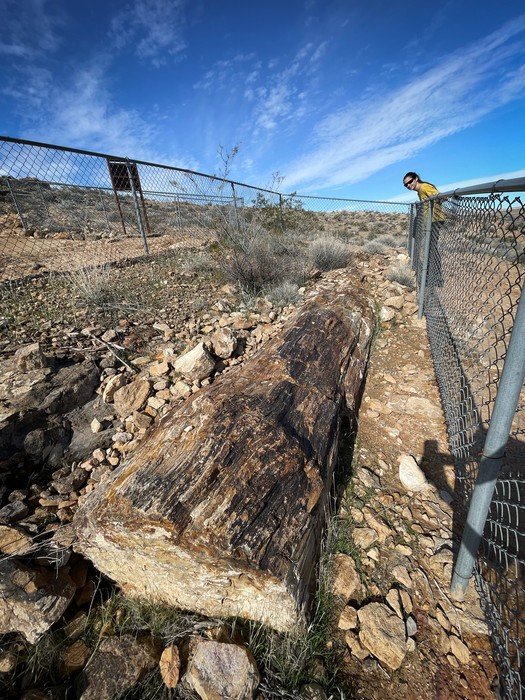
12. Petrified Logs
The first is in the northeast part of the park, and the other is on the southwest end, where you’ll find the Petrified Logs Loop. This trail runs past fenced-in areas with several fossilized logs and interpretive signs with more information about the park’s petrified wood.
13. Visit the Fire Canyon/Silica Dome, one of the best things to do in Valley of Fire
If you want to see what gives the Valley of Fire its name, check out the Fire Canyon and Silica Dome.
The Silica Dome is a mound that serves as an excellent lookout point over the desert valley. While it’s not a towering peak, it’s a gorgeous place to enjoy the views. This white dome is made mostly of silica, although the base contains iron, which adds a fiery touch.
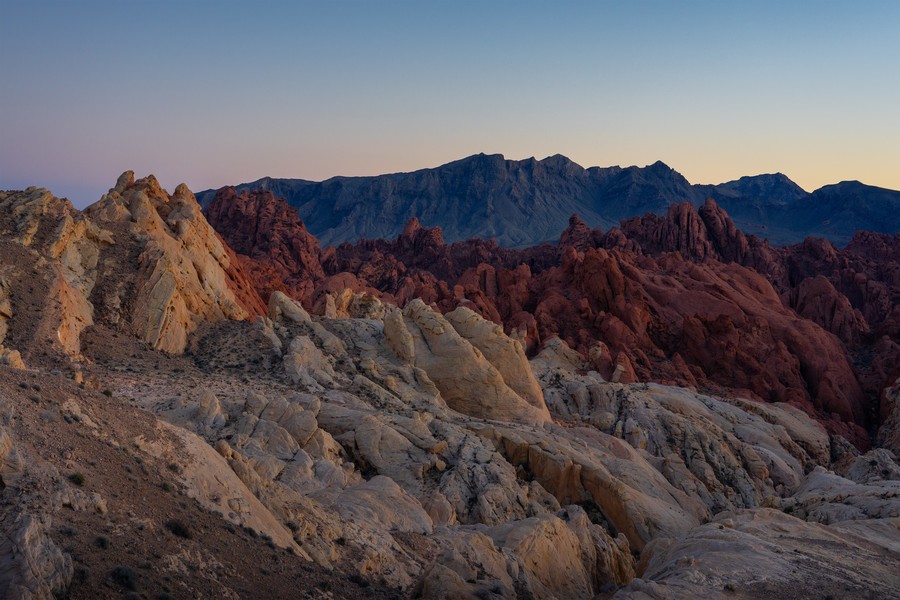
13. Visit the Fire Canyon/Silica Dome, one of the best things to do in Valley of Fire
From the Fire Canyon parking lot, follow the trail and scramble over the slickrock to get to the Silica Dome. From here, look out and see the Fire Canyon, a large expanse of jutting rock formations. Here, you can take in the panorama and marvel at the textured landscape of rocky peaks.
This Valley of Fire trail is well worth it, and it’s usually less crowded than the White Domes Trail. Also, keep your eyes peeled for bighorn sheep!
14. Seven Sisters, a lovely attraction in the Valley of Fire
Visiting the Seven Sisters is one of the most popular things to do at Valley of Fire. These seven red boulders stand in the middle of the desert and are easy to find, making them one of the park’s top sights.
The sisters were once part of the nearby rock formations, but years of erosion led to their separation. The sandstone structures will continue to brace the elements and eventually erode, but not for hundreds of years.
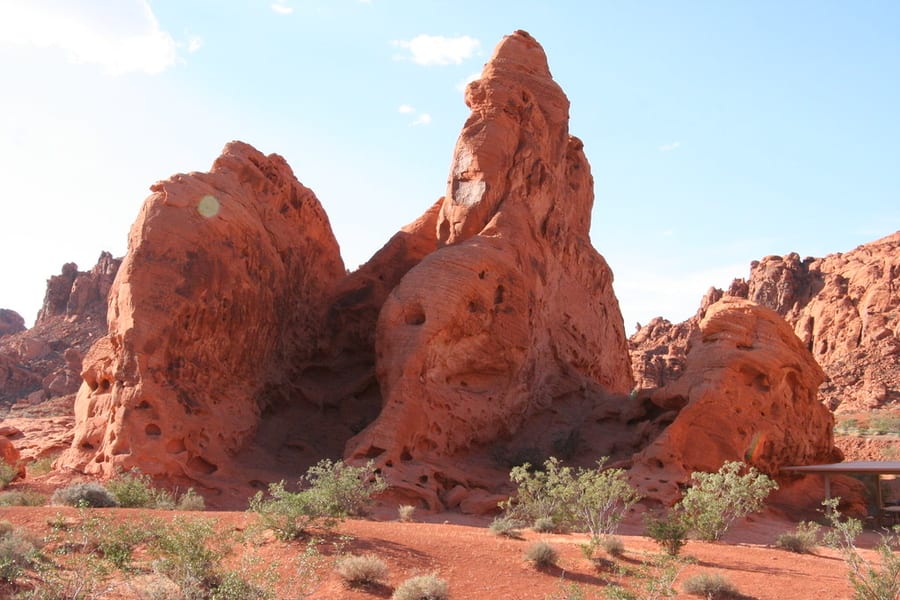
14. Seven Sisters, a lovely attraction in the Valley of Fire
To see this attraction, take Old Arrowhead Road and follow the signs until you spot the distinct line of towering red rocks. There isn’t much else to see in this area, so spend some time exploring this unique and peaceful landscape.
The surrounding area has a parking lot, picnic area, and restrooms, and the Seven Sisters is a common site for Valley of Fire weddings.
15. Watch for bighorn sheep and other Valley of Fire wildlife
While the magnificent sandstone structures are the main attraction, the Valley of Fire’s wildlife is also worth checking out. I suggest stopping at the Visitor Center to grab a visual guide that can help you spot the critters that call this place home.
The park’s desert fauna ranges from reptiles and insects to rodents and larger mammals. Some of them you can spot while journeying along the Valley of Fire scenic drive, while others will require a bit more effort.

15. Watch for bighorn sheep and other Valley of Fire wildlife
During your visit, you may come across desert reptiles like rattlesnakes, Gila monsters, iguanas, and lizards. The park also serves as a habitat for small creatures like jackrabbits, antelope ground squirrels, and kangaroo rats. If you’re lucky, you may see a desert tortoise making a quick appearance before returning to its shady burrow.
Keep an eye out for larger animals like badgers, coyotes, kit foxes, and bighorn sheep. There are also several bird species in the Valley of Fire, such as finches, roadrunners, quail, hawks, and hummingbirds.
Finally, don’t forget about the desert flora! There are several species of cacti and wildflowers here, just to name a few examples.
Where is the Valley of Fire – How to get there
Visiting the Valley of Fire from Las Vegas is a great idea if you’re going to be in the area for a few days or you’re passing through. The state park is less than an hour from the city, so it’s an easy trip. Below, I’ll share directions to the Valley of Fire and my favorite day tour to Valley of Fire from Vegas.
Valley of Fire from Las Vegas
Many travelers make their way to the Valley of Fire from Las Vegas, and taking a day trip to the park is one of the top things to do outside Las Vegas. If you’re wondering how far the Valley of Fire is from Las Vegas, it’s just 50 miles, and the directions are simple.
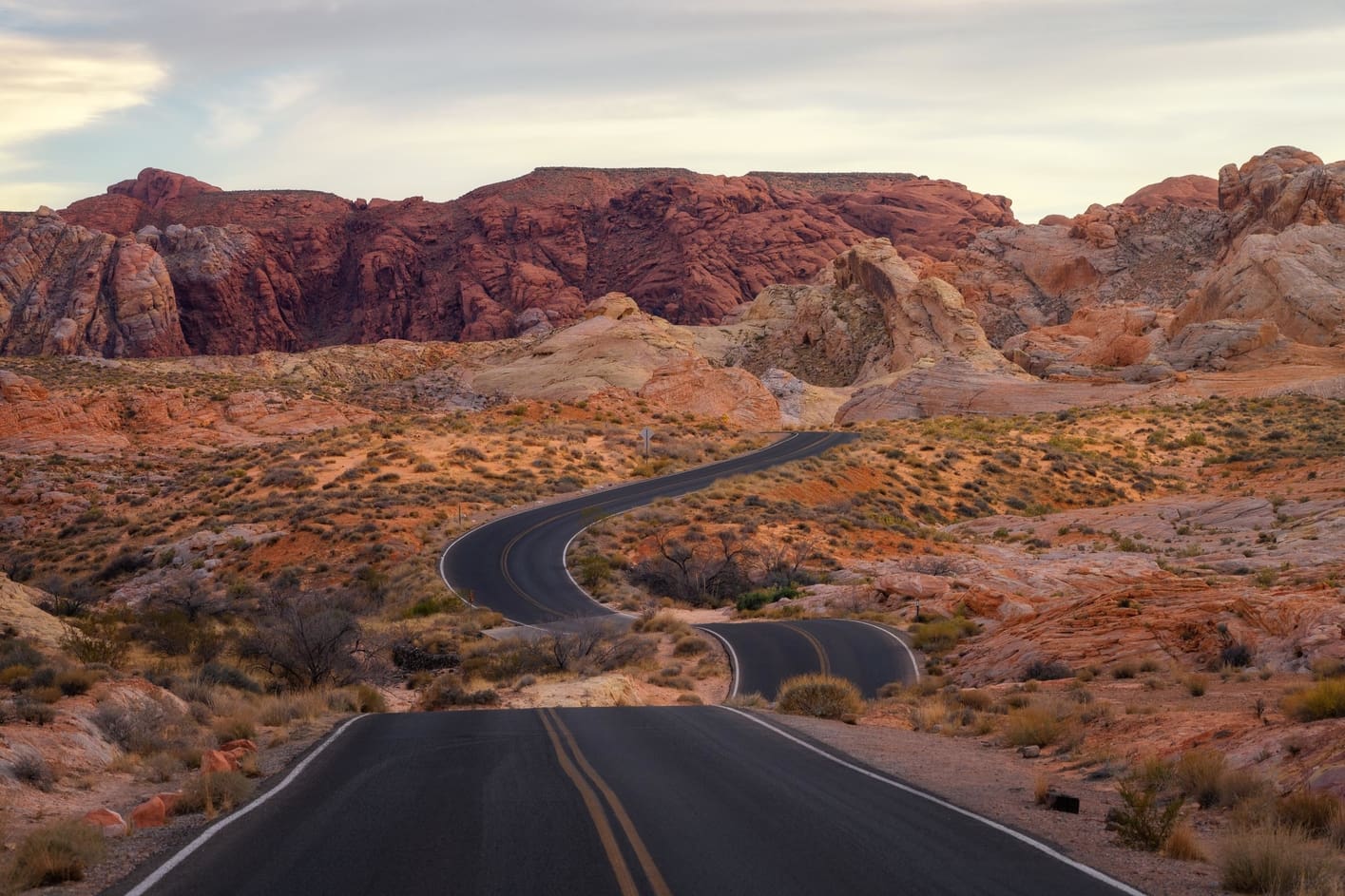
Where is the Valley of Fire – How to get there
To get there, follow I-515 N/US-95 N for 33 miles and take Exit 75. Merge onto the Valley of Fire Highway and continue until you reach the state park.
The drive only takes 45 minutes to an hour, but if you want to take a pitstop, you can check out the Vegas Speedway or Gypsum Cave, a 5-room cave in Sunrise Mountain.
Valley of Fire tours
If you’re going to be in Vegas and won’t have a car, consider taking a Valley of Fire tour. We loved the guided tour we took, so I highly recommend it if you’d like to visit the state park from Vegas.
Valley of Fire weather and best time to visit
Since it’s in the Mojave Desert, the Valley of Fire’s weather stays warm and dry year-round. Regardless of when you go, try to get to the park as early as possible, when the temperatures are the coolest.
The best time to visit the Valley of Fire is from mid-autumn to mid-spring (October-April). This way, you can avoid the extreme summer heat, which can easily reach 100°F. That said, winters are still mild here, with temperatures in the 50s, 60s, or even 70s.
Valley of Fire hours and entrance fee
The park is open daily from sunrise to sunset, and the entrance fee is $15 per vehicle ($10 for Nevada residents). If you want to camp in the Valley of Fire, the fee is $25/night per vehicle ($20 for Nevada residents).
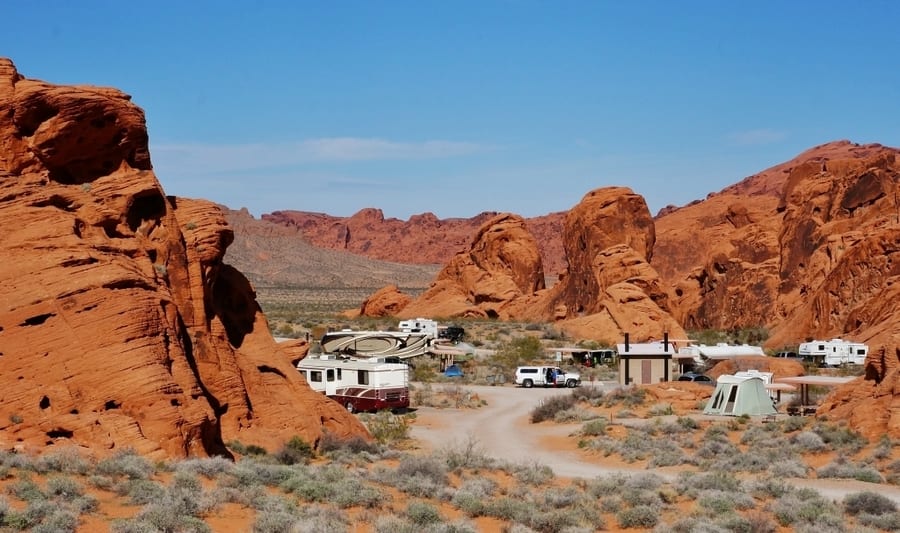
Valley of Fire hours and entrance fee
Once you enter the park, I recommend stopping by the Valley of Fire Visitor Center, which is open daily from 9 am to 4 pm. There, you can find trail maps, hiking information, and exhibits about the geology and history of the park.
Where to stay in Valley of Fire
If you’re planning on staying overnight, you can either camp at the Valley of Fire or sleep in one of the hotels near the Valley of Fire.
Camping in Valley of Fire, Nevada
There are two Valley of Fire campgrounds, the Atlatl Rock and Arch Rock campsites. If you’re interested in staying overnight or RV camping at Valley of Fire, we wrote a complete guide that you can check out.
Hotels near Valley of Fire
If you don’t want to camp, you can stay at a hotel near the Valley of Fire. I recommend the North Shore Inn at Lake Mead, which is the closest to the state park and has very good reviews.
Other tips for visiting Valley of Fire State Park, NV
Finally, I’d like to leave you with some tips to make your visit to the Valley of Fire even more enjoyable:
- With so many things to do in the Valley of Fire, plan your itinerary to make the most of your time.
- Make the Visitor Center your first stop so you can grab Valley of Fire trail maps and hiking guides.
- Arrive early to beat the heat, and don’t forget the sunscreen.
- Prepare for the weather at Valley of Fire by wearing light-colored, loose-fitting clothes, sunglasses, and a hat. Closed-toe shoes are best for walking on the sandy terrain.
- Bring plenty of water and snacks.
- Consider a Valley of Fire tour if you don’t want to drive or won’t have a car.
- Leave no trace! Pick up after yourself, don’t litter, and leave the area just as you found it.
- Don’t feed the wildlife but have your camera ready for animal encounters.
Valley of Fire map
I also have a Valley of Fire map for you! Keep this map handy to help you easily locate all the attractions you want to see.
That’s it from me! I hope you enjoyed reading about all the things to do in the Valley of Fire and that this guide helps you plan the perfect trip. Of course, if you have questions about the park or getting to the Valley of Fire from Las Vegas, leave me a comment, and I’ll help. Safe travels!
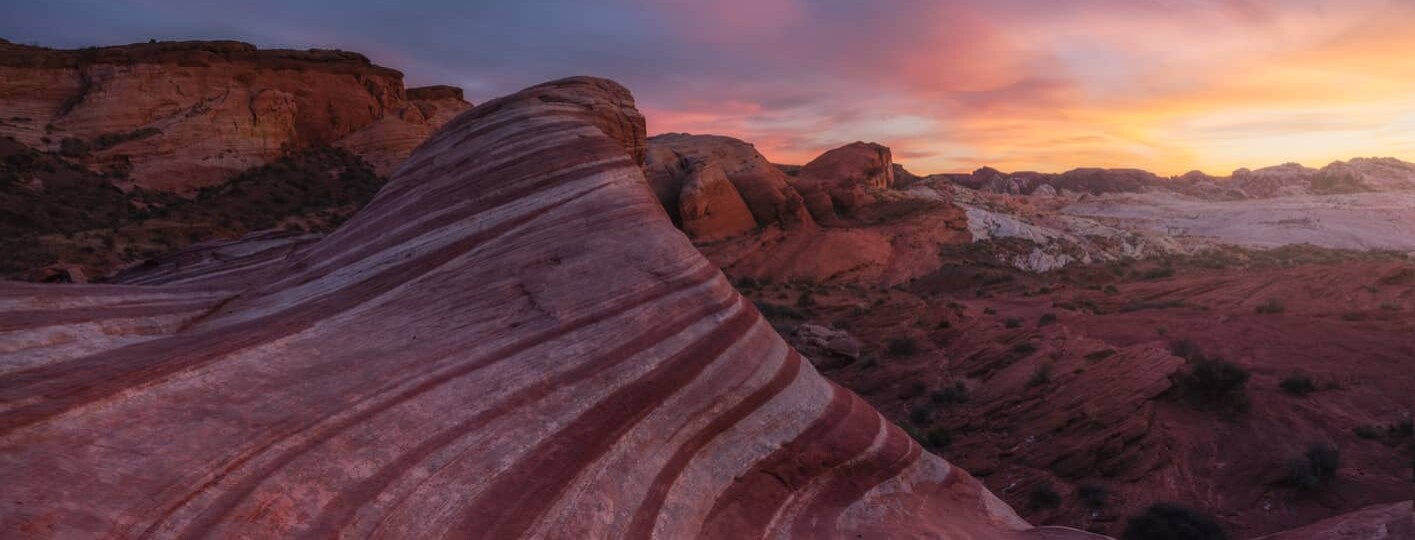
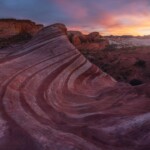
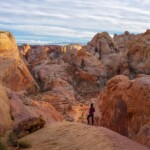
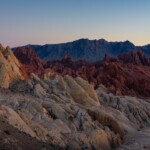
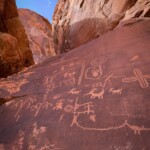
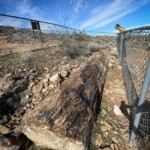
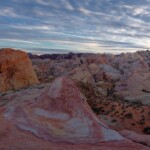
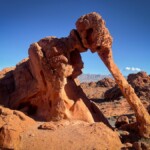

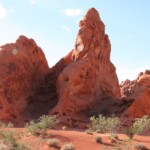
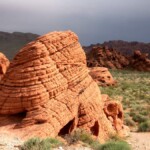
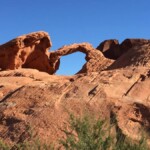
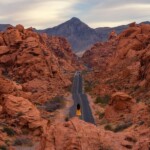
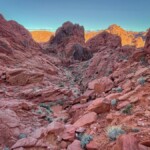
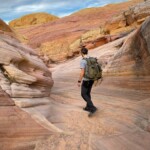
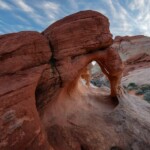
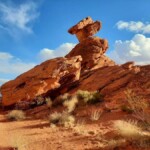
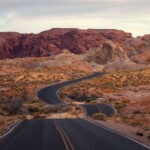

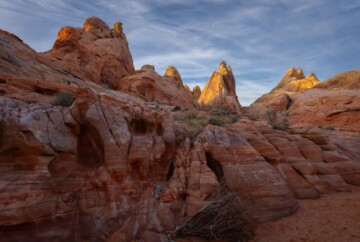
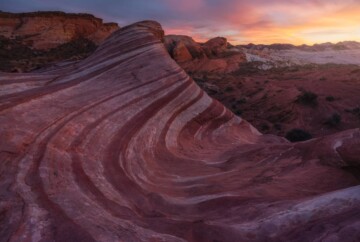
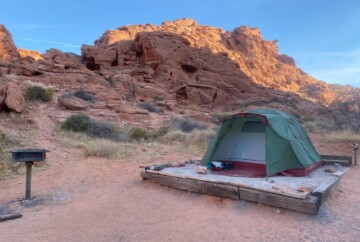







Which tour exactly did you do to visit all these amazing landmarks in the Valley of Fire? and which hike (moderate? hard?)?
Thank you so much for your help!
This is amazing!! 🙂
Hi Sandra,
We’ve done a few hikes through the Valley of Fire. Most recently, we did the Fire Wave trail and ventured deeper into the park. It was awesome! No crowds, and one of the most amazing sunsets ever. I highly recommend it!
Thanks for sharing that. We just visited a week ago and were amazed at the Valley’s other-worldly beauty. Hopefully it can be a future destination for a “re-visit” , maybe with grandkids. Such a beautiful and refreshing trip to step away from Vegas.
Thanks, Mark,
I can’t wait to revisit this fantastic natural wonder. Valley of Fire is one of my favorite places in the world.
Ascen